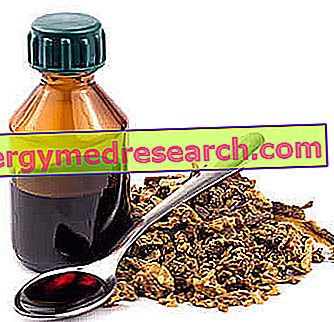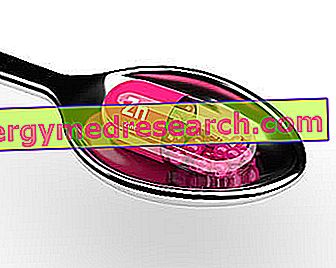What is Pomegranate Juice?
Pomegranate juice: introduction
Pomegranate juice (or better, pomegranate) is a drink obtained by the liquid extraction, by cold pressing, of the pomegranate fruits ( P. granatum ).

Equipped with excellent nutritional properties, pomegranate juice is considered a real "panacea". Energizing, due to the considerable sugar content, and source of minerals, vitamins and other antioxidants, pomegranate juice is suitable for most diets. It is considered the antioxidant drink par excellence, even if, as often happens, marketing has contributed to distorting what is true about the subject.
To obtain a good pomegranate juice it is necessary to use the dedicated cold squeezer (manual); some use the juicer. The pomegranate juice should not be confused with the extract and the centrifuged, beverages obtained respectively with different appliances (extractor and centrifuge).
Insights: Generalities on pomegranate and pomegranate
The pomegranate (in English "pomegranate") is a tree belonging to the Lythraceae family that grows up to 5-8 m in height. In the northern hemisphere, therefore also in Italy, it produces typically autumnal fruits (from September to February); in the southern hemisphere it bears fruit in spring (from March to May).
The pomegranate is native to the area that extends from today's Iran through Afghanistan and Pakistan to Northern India. Since ancient times it has been widespread and cultivated throughout the Mediterranean region. It was introduced from the Spanish colonies in America only in the second half of the 16th century and in California in the second half of the 1700s. Today it is widely distributed throughout the Middle East and in the Caucasus region, in Northern and tropical Africa, in Southern Asia, in Central Asia, in the most arid parts of Southeast Asia and in some parts of the Mediterranean Basin. It is also being cultivated in some parts of Arizona and California. In the 20th and 21st centuries it has become very common in European commercial markets and, in a general sense, in the Western hemisphere.
The edible part of the pomegranate is the set of arils (small internal seeds individually wrapped, and separated, in fleshy receptacles); these, which could be identified as "fruit pulp", are used raw and cooked, as an independent food, for the extraction of juices, plate garnishes, fermentation of alcoholic beverages etc.
For more information on pomegranate and pomegranate it is advisable to read the dedicated article: Pomegranate.
Nutritional Properties
Premise on the composition of pomegranate juice
Establishing the nutritional characteristics of pomegranate juice is not easy. While the chemical profile of whole pomegranate arils is now completely defined, no one has yet analyzed in detail the juice one. The extraction of liquids is in fact a process that completely separates the "edible part" from the "non edule", also discarding a part of the residues normally classified among the dietary fibers.
Pomegranate juice is, in some ways, more concentrated and nutritious than whole pomegranate arils. Nevertheless it is almost totally deprived of all the non-digestible components. Some of these are woody and do not constitute a desirable nutritional factor; others, on the other hand, promote colon health and the trophism of intestinal bacterial flora.
Nevertheless, it is essential to remember that among the various nutritional components of the pomegranate, some are contained within the seed. Chewing them as whole food, after having shelled it, we would have the possibility of extracting a certainly significant percentage (as happens, for example, for grapes). On the other hand it is not clear in what amount, squeezing the fruit half at a time thanks to a hybrid contraption between a juicer and a press, these spread in the juice.
The pomegranate is edible up to 59%. This means that to obtain a portion of juice (about 125 ml) we should use a pomegranate weighing approximately 210 g. However, it is necessary to reflect on the accuracy of this calculation. Pomegranate fruits are indeed very different from each other and sometimes the yield is significantly higher or lower.
General nutritional characteristics of pomegranate juice
Pomegranate juice is obtained from the processing of a product that is part of the VII fundamental group of foods (foods rich in fructose and vitamin C).
It has a significant energy supply, composed almost entirely of carbohydrates; they follow quantitatively less significant percentages of lipids and proteins. Pomegranate juice carbs are simple, soluble, made from fructose. The proteins, of low biological value, do not contain the essential amino acids in the right quantities and proportions; it is also possible that, except for the free amino acids, most of the peptides contained in the pomegranate arils remain in the waste of the pressing. The distribution of fatty acids is not known, therefore their potential impact on the metabolism, and we limit ourselves to specifying that their presence is however important for the absorption of other liposoluble nutrients such as vitamins and phytosterols.
Pomegranate juice does not produce significant fiber concentrations. Cholesterol is absent, replaced by plant sterols, gluten, lactose and histamine (the latter three, often responsible for food intolerance).
As for minerals, pomegranate juice is considered an excellent source of potassium. With regard to vitamins instead, the levels of water-soluble folate (of group B), vitamin C or ascorbic acid and of liposoluble K (anti-haemorrhagic function) stand out.
Antioxidant phytocomplex of pomegranate juice
Pomegranate is rich in vitamin C, a water-soluble molecule with an antioxidant and essential for the immune system, collagen synthesis, etc. However, ascorbic acid is not the only nutritional factor useful in the fight against free radicals contained in pomegranate juice.
Normally absent in the chemical-nutritional tables, the antioxidant polyphenols are the substances that have given the pomegranate juice the reputation of an antioxidant phytocomplex. Among the various elements we recall:
- Hydrolyzable tannins: called punicalagins or ellagitannins, they are formed by the union of ellagic acid with gallic acid and a molecule of carbohydrates. They are currently undergoing scientific experimentation for possible health benefits. In vitro and in vivo studies have shown that most of their beneficial effects are due to the transformation of the ellagitannins into urolithines (metabolites) by the intestinal bacterial flora
- Red anthocyanins (contained in the pulp, are more concentrated in the ripe fruit): the most abundant are delphinidin, cyanidin and pelargonidin glycosides. Instrumentalised in advertising campaigns, however, the pomegranate anthocyanins have not been scientifically proven to exert therapeutic effects such as anti-cancer and anti-aging effects. For this reason, the FDA has sanctioned certain industrial producers of pomegranate juice for spreading unfounded and therefore illegal claims on the subject.
Note : The phenolic content of pomegranate juice is negatively influenced by industrial processing techniques, especially pasteurization.
Pomegranate peel: a concentrate of polyphenols
Compared to the pulp, the pomegranate peel, although not edible, contains up to three times the total amount of polyphenols (condensed tannins, catechins, gallocatechins and prodelfinidines) compared to the pulp of the seeds. It is no coincidence that pomegranate peel is used, on an industrial level, for the production of food supplements and preservatives.
As the pomegranate juice is obtained, as we have said, squeezing the two halves of the whole fruit one at a time, it is possible that this also contains a part of the antioxidants of the peel. It should however be emphasized that the juice extraction method tends to be imperfect, not totally effective, since during crushing the pulp liquids impregnate the peel which acts as a "sponge", retaining a part of the nutritional factors inside (the residue of the processing is in fact red due to the retention of anthocyanins from the pulp in the skin).
On balance, the nutritional concentration of nutrients and polyphenols in pomegranate juice, compared to a centrifuged or aryl extract, may not be so advantageous.
Pomegranate juice in the diet
The pomegranate juice is to be avoided completely only in case of allergy. It is suitable for most diets; however, we must not forget that it is a sweet drink in all respects. The discrete amount of energy given by the sugars can interfere with the nutritional balance in the nutritional scheme of the obese, of the diabetic (type 2 mellitus) and of the hypertriglyceridemic.
Especially in the children's diet, pomegranate juice can be an excellent alternative to carbonated drinks and commercial fruit juices. It is however essential to produce it or buy it fresh, unpacked, and drink it instantly to keep its nutritional characteristics intact. The wealth of water and potassium lends itself to the diet of the sportsman and those suffering from primary arterial hypertension. The abundance in folates, on the other hand, is an excellent pretense to be able to insert it among the nutritional habits, perhaps as a snack, of the pregnant woman.
Pomegranate juice is relevant to vegetarian, vegan and raw food eating habits. It is not prohibited by any religion or philosophy.
The average portion of pomegranate juice is 100-150 ml (85-125 kcal).

| Nutritional Values per 100 g of Pomegranate Pulp | ||
| Edible Part | 59% | |
| Nutrients | Quantity' | Percentage US adults * |
| Power | 83 Kcal | |
| Carbohydrates | 13.67 g | |
| Sugars | 13.67 g | |
Food fibers | 4.0 g | |
| Grassi | 1.17 g | |
| Protein | 1.67 g | |
| Vitamins | ||
Thiamine or Vitamin B1 | 0.067 mg | (6%) |
Riboflavin or Vitamin B2 | 0.053 mg | (4%) |
Niacin or Vitamin PP | 0.293 mg | (2%) |
Pantothenic Acid or Vitamin B5 | 0.377 mg | (8%) |
Pyridoxine or Vitamin B6 | 0.075 mg | (6%) |
| folate | 38μg | (10%) |
| Choline | 7.6 mg | (2%) |
Vitamin C or Ascorbic Acid | 10.2 mg | (12%) |
Vitamin A or RAE | 15μg | (2%) |
Vitamin E or Tocopherols | 0.6 mg | (4%) |
Vitamin K (Antihemorrhagic) | 16, 4μg | (16%) |
| Minerals | ||
| Football | 10 mg | (1%) |
| Iron | 0.3 mg | (2%) |
| Magnesium | 12 mg | (3%) |
| Manganese | 0.119 mg | (6%) |
| Phosphorus | 36 mg | (5%) |
| Potassium | 236 mg | (5%) |
| Sodium | 3 mg | (0%) |
| Zinc | 0.35 mg | (4%) |
| water | 80.5 g | |
* Approximated on US (US) recommendations for the adult population.
Pomegranate squeezer
Differences between pomegranate squeezers, extract, centrifuged and juice
The pomegranate squeezer is a tool designed to make pomegranate juice. Juice, extract, centrifuged and juice are not synonymous. Although not very relevant, the four products may show some differences:
- Pomegranate juice: obtained by squeezing whole pomegranate, so not only arils but also peel; the fruit must first be cut in half on the transverse plane. It is obtained by means of manual pomegranate squeezers
- Pomegranate extract: obtained by extracting the juice from the arils previously shelled from the whole fruit. It is obtained by means of an electric - electronic extractor
- Pomegranate centrifuge: obtained by centrifugation from chopped arils, previously shelled from the whole fruit. It is obtained by means of an electric - electronic centrifuge
- Pomegranate juice: apparently synonymous with the previous three, it is instead the most suitable noun to indicate the commercial product, sold mainly in brik or in a plastic or glass bottle.
Types and description of pomegranate squeezers
There are different types of pomegranate awards. As always, the market offers dozens of solutions that adapt to different consumer needs. The innumerable products could be subdivided fundamentally into two macro-groups: pomegranate squeezers manual and pomegranate electric - electronic squeezers.
Not everyone agrees to differentiate the juicer from the pomegranate squeezer. In fact, these tools show quite similar characteristics between them. The simplest manual ones are in plastic and equipped with a protuberance, mounted on a filter that blocks the solid residues, through which the half pomegranate is impaled, crushed and squeezed; the juice is stored by a tank at the base. The average price of the instrument is € 15.
The most advanced manual pomegranate squeezers instead, although operating with the same principle, are generally metallic, articulated, adopt various levers and guiding mechanisms to increase the squeezing force, decreasing the effort; they are more expensive but also more effective and efficient. The average price varies according to the materials, from 25 to 150 €
An intermediate category between the previous two is that of the manual press, also used to squeeze different foods. The average price is between € 25-80.
The pomegranate electric - electronic squeezers are very rare, instead replaced by extractors and centrifuges. The price is very variable (from 50 to 250 €) based on technology, brand, additional functions, etc.



